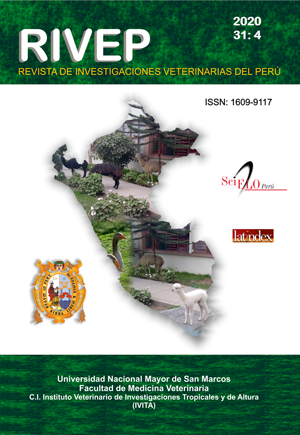Association between the presence of antibodies against Leptospira and kidney lesions in cattle
DOI:
https://doi.org/10.15381/rivep.v31i4.19028Keywords:
renal lesions, leptospirosis, cattle, Leptospira spp, serologyAbstract
The aim of this study was to determine the possible relationship between the presence of lesions called “White Spotted Kidney” (WSK) and the seroprevalence of Leptospira spp in cattle slaughtered in the Manta slaughterhouse, Manabí province, Ecuador. Blood samples were taken from 320 cattle to detect antibodies against Leptospira spp using the microagglutination technique. Likewise, a macroscopic revision of the kidneys was made, and samples were taken for histopathological analysis. The seroprevalence of Leptospira spp was 50.9% and the frequency of kidney injury was 18.13%. The presence of the eight serovars evaluated was found, with the serovars Pomona, Icterohaemorragiae and Bratislava being the most frequent. Animals serologically positive for Leptospira are 40.56 more likely to have specific lesions associated with the disease at the time of slaughter (p<0.00001; OR = 40.56; 95% CI = 9.86-169.79). A significant association was found between the presence of kidney lesions with the serovars Icterohaemorragiae, Canicola, Hardjo and Wolffi. No association was found between the presence of lesions with the sex of the animals or with the canton of origin. It is concluded that there is a relationship between seroprevalence to Leptospira spp and the presence of kidney lesions (WSK).
Downloads
Downloads
Published
Issue
Section
License
Copyright (c) 2020 Daniel Isaías Burgos Macías, Carlos Aníbal Bulnes Goicochea, Miguel Pérez Ruano, Alexandra Paola Revelo Ruales, Mercy Alexandra Falconí Flores, Lino Vera Loor, Rafael Angel Joa Rodríguez, Osvaldo Fonseca Rodríguez

This work is licensed under a Creative Commons Attribution-NonCommercial-ShareAlike 4.0 International License.
AUTHORS RETAIN THEIR RIGHTS:
a. Authors retain their trade mark rights and patent, and also on any process or procedure described in the article.
b. Authors retain their right to share, copy, distribute, perform and publicly communicate their article (eg, to place their article in an institutional repository or publish it in a book), with an acknowledgment of its initial publication in the Revista de Investigaciones Veterinarias del Perú (RIVEP).
c. Authors retain theirs right to make a subsequent publication of their work, to use the article or any part thereof (eg a compilation of his papers, lecture notes, thesis, or a book), always indicating the source of publication (the originator of the work, journal, volume, number and date).



